An evening with Mr Sagar Dhara
On August 9, we had an insightful session by Mr. Sagar Dhara, a distinguished Environmental Scientist and Sustainability Advocate.
About Mr Sagar Dhara
Mr. Sagar Dhara is a researcher and writer, with a deep understanding of the energetics (energy flows) of human society. Mr Dhara has made significant contributions in various capacities. He has been a faculty member at BITS Pilani, Director (Safety) at Envirotech Consultants Pvt Ltd, and an Environmental Engineering consultant for UNEP.
Mr Dhara has been an active member of several key committees, including the Monitoring Committee of the Male Programme (UNEP), the Supreme Court Committee on Hussain Sagar Lake, the Government of India Task Force on EIA & Environmental Clearance, and various state-level environmental committees in Andhra Pradesh.
Mr. Dhara has worked tirelessly with trade unions, farmers' unions, civil rights groups, adivasi movements, and people's movements for over 40 years, championing environmental justice and sustainability.
Mr. Dhara is affiliated with the South Asian People's Action on Climate Crisis (SAPACC), a coalition striving for sustainable and equitable solutions to climate change.
Mr Dhara holds a BTech in Mechanical Engineering from the prestigious Indian Institute of Technology, Bombay.
Being part of the problem
For all his achievements and scholarship, Mr Dhara is grounded and has a high degree of self-awareness. He (and that applies to all of us, if we pause to think) considers himself to be male, upper class, university educated, city slicker, member of the most ferocious predatory species that ever stalked the earth. That description itself conveys that we are part of the problem: Humans have been exploiting nature for a long time. Only if we realize we are a part of the problem, we will move towards a solution. Otherwise, we will wash our hands off. This realization is indeed critical if we want to deal with climate change.
World War Zero
We are familiar with World War I and World War II. Now there are concerns about World War III. But these wars are more recent. We do not realize that there is a much older war that humans have waged against nature to extract increasing amounts of energy and raw materials. This began around the time when we transitioned from hunter gatherers to farmers.
We must remember that wars are all about using high doses of energy to kill the enemy. In World War Zero we have been using energy to destroy nature. Every year, for 8000 years, we have used energy power of 20,000 Hiroshima sized bombs. We have slaughtered about a third of the forest cover.
However, amidst all this plundering, we forget that the energy flows of nature are huge and we cannot master them. During the Orissa cyclone of 1999, Mr Dhara was at the spot. He estimated that the amount of energy released was 3 times the total power generation capacity of Orissa. There were 3 storm surges 150 km in length and 10 meters in height. Some 50,000 people were killed.
Economics has facilitated World War Zero by encouraging the conversion of nature into artefacts and by not distinguishing between renewable and non-renewable resources. The way economic calculations are done, allows degradation of the environment without economic penalty.
The Kerala floods of 2018 are a good example of the price we pay when we damage the environment. It was a combination of climate change and human actions. Due to climate change, extreme weather events, (in this case heavy rainfall) are more likely. In the western ghats, trees have been cut down and replaced by plantations. The planted trees have shallow roots and do not hold the soil firmly. So, during heavy rains, the soil came off and the boulders started falling down, leading to landslides.
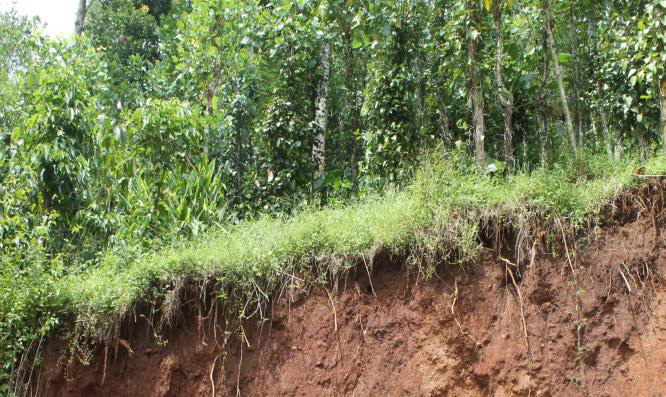
Mr Dhara narrated another example. On October 3, 2023, a Glacial Lake Outburst Flood (GLOF) from South Lhonak Lake in North Sikkim breached, causing massive devastation. (A glacial lake outburst flood (GLOF) is a type of outburst flood caused by the failure of a dam containing a glacial lake. The dam can consist of glacier ice or a terminal moraine.) The 1,200 MW Teesta III dam downstream was destroyed, resulting in 40 lives lost, 76 missing, and extensive damage to infrastructure. A landslide into South Lhonak lake was the likely trigger.
Other recent GLOFs include:
-
Cirenmaco, 1981, Sun Koshi River, China
Dig Tsho, 1985, Dudh Koshi, Nepal
Tam Pokhari, 1998, Dudh Koshi, Nepal
Chorabari Lake, 2013, the Alaknanda River basin, India
Central and Eastern Himalayas are more prone for GLOF occurrence.
Here are some examples of extreme weather events.
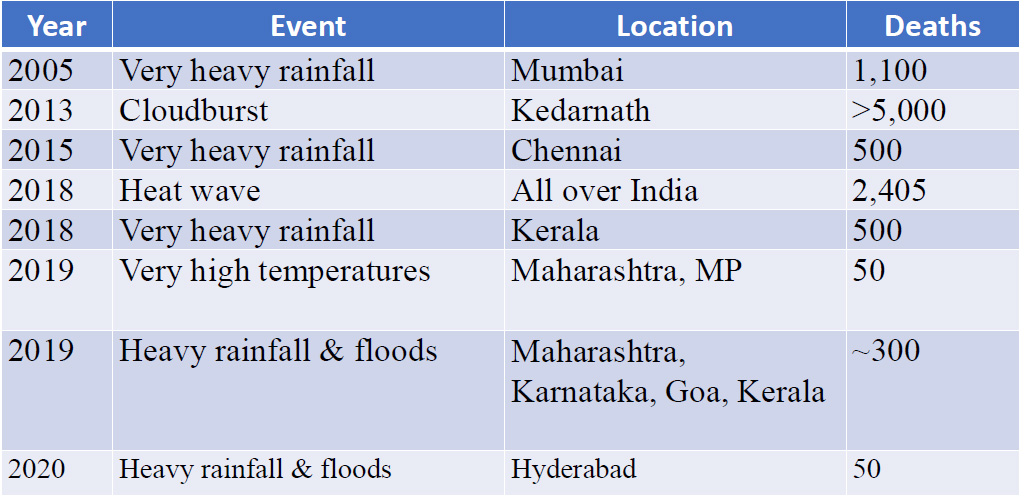
Origin of the Cauvery River: A telling story
Mr Dhara then narrated an episode from Indian mythology to make an important point. Asura Surapadma was angry with Indra who was escaping arrest while trespassing his land. He ordered Varuna, God of water, to banish Indra from South India. Varuna ensured that rains failed in South India. Famine, and hunger ensued. Many humans and animals died.
Agasthya Muni was passing through and was moved by the enormity of the disaster he saw. He prayed to Lord Shiva to provide relief to all affected people, animals and non-living things. Lord Shiva gave Agasthya a kamandalam and told him that a mighty river would start wherever the holy water spilled over. But Lord Shiva specified that the river’s water was for people, animals and non-living things as well. Eventually, the water from the kamandalam did spill over and the Cauvery originated but we forgot that the waters are to be shared with all and not just enjoyed by humans.
Unsustainable growth
Rising growth has fuelled unsustainable growth in energy consumption.
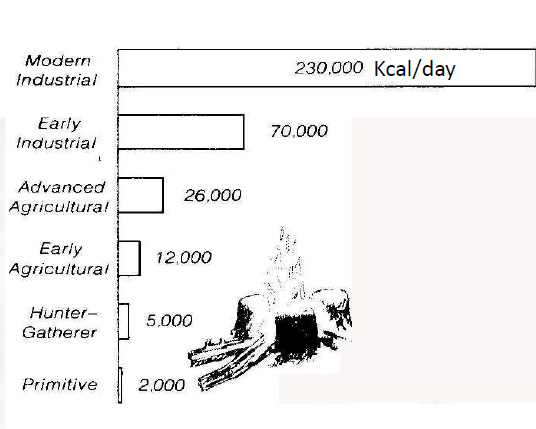
Per capita energy use of today’s society is 50 times that of hunter gatherer. Energy use today is more than 50,000 times what it was 10,000 years ago. From 1 AD to 1800, global population, energy and GDP grew at about 0.1% pa. After the discovery of fossil fuels, from 1800-2010, global population and energy grew at about 1.1-1.4% pa but GDP at a much higher 2.4% pa.
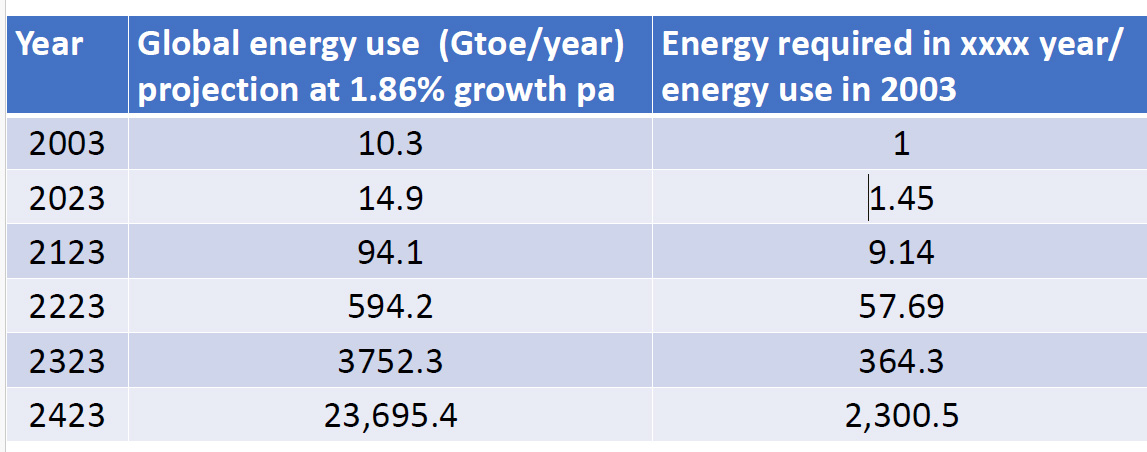
Note: Gtoe: Gigatonne of oil equivalent is a unit used to describe global energy use.
Three tipping points
Tipping Point 1
The first is peak oil with no suitable energy alternatives and exhaustion of critical non-renewable minerals. More than 50 billion tonnes of non-renewable minerals are used every year. Production of more than 90 critical non-renewable minerals will peak in the next few decades.
Tipping point 2: Climate change
The CO2 concentrations have increased to an unacceptable level of 412 ppm today. The Paris Agreement aims to limit warming to 1.5-2 °C above pre-industrial levels. For that, global emissions must halve by 2030 and become net zero by 2050. (Today, global emissions are growing at 1.2% pa. To be 1.5 °C compliant, they must decrease by 15% pa.) Each country may make a non-binding pledge on how it wishes to mitigate global warming.
The cuts required are ambitious but still doable. The world needs a fivefold increase in current collective commitments. Current policies are likely to cause a ~3 °C warming by 2100. But under worst case scenarios, it may be double that.
There is a north south divide that is relevant in this context. The Global North accounts for 16% of the world’s population but has consumed 70% of fossil fuels. The average per capita GDP of these countries is $45,000. The Global South accounts for 84% of the world’s population and has consumed 30% of fossil fuels. The average per capita GDP is $5,000. To restrict warming to less than 0.5 °C, about 100-400 GtCO2 can be emitted. The current emission rate is about 40 GtCO2. The remaining carbon space will vanish in the next few years.
If developing nations burn more fossil fuels to accelerate their development, they will contribute to warming that will exceed 1.5–2°C. If they restrict their emissions, they will remain permanently backward compared to developed countries. So, it is a catch 22 situation! But even if the entire remaining carbon space of 400 GtCO2 is given to the developing countries, they cannot achieve the material development standards of developed countries.
Note: There are 3 categories of countries, and they have different interests.
- Developed countries that have already reached a standard of living and want to maintain it by controlling global warming. They therefore want Net zero now.
- High emitting developing countries, e.g., China and India, want to develop. Therefore, they want to burn more fossil fuels. They talk of climate justice vis a vis developed countries, but do not offer it within their country.
- Low emitting vulnerable developing countries, e.g. Bangladesh, Maldives, Tuvalu, etc. They want the other two categories of countries to stop emitting as whoever emits, they are going to be badly affected.
We should also note that some of the regions most vulnerable to climate change are located in the developing world in Africa and South Asia.
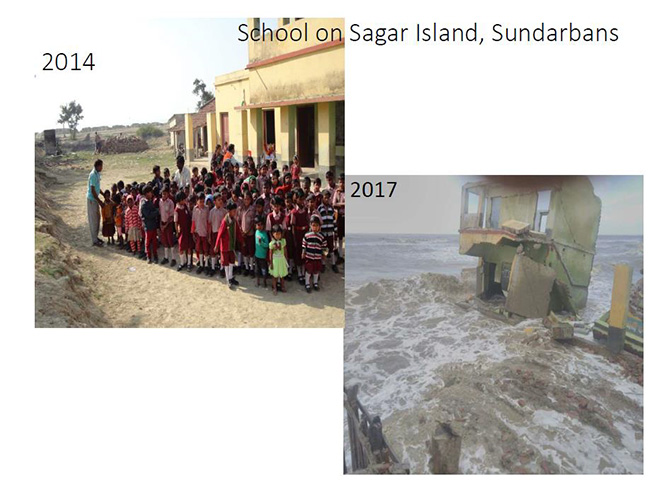
As examples, Mr Dhara mentioned that a school in the Sundarbans is gone. See figure above. Eluru and Bhimavaram in coastal Andhra Pradesh are getting submerged under water. About 15-20% of Bangladesh is gone. The country may generate more than 10 million climate refugees. We can expect them to move into India. So India cannot be immune to the challenges faced by Bangladesh.
Other Asian countries will also be affected. Pl see table below.
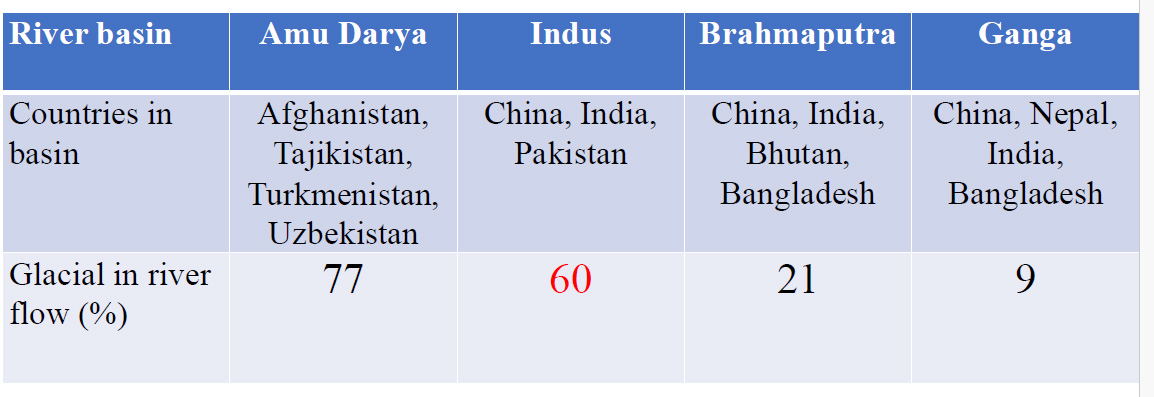
India’s target of achieving net zero by 2070 is not enough. We must get there much earlier. We must transition from high energy to low energy systems.
Tipping point 3: Inequality
Inequality between people and between nations is a major worry and a likely source of conflict. Think of interstate wars, colonial wars and civil wars. Inequality in the context of climate change means the energy extracted has been distributed unequally.
Colonialism aggravated the inequality among nations. For example, Britain drained out $ 45 tn of wealth from India. There are other types of conflict as well. Property owners are stealing energy from non-property owners. There is a conflict between agriculture and industry. Agricultural products consume more of solar energy. They are being penalized by industry which consumes more of the polluting fossil fuels.
Inequality has only been growing with time. The top 1% of the population’s income accounts for 19% of total income. The bottom 50% of the population’s income account for 9%. Income inequality in India is higher now than under the British.
Root cause of growth
Humans consider themselves to be the most important species. Nature is for their use and enjoyment. Anthropocentrism legitimizes unbridled use of nature for humans. Humans have developed expertise in extracting energy from nature and converting it into forms that are useful to them. Energy over utilization is a direct consequence.
National programmes
Lobbying with the government is necessary. We should make the following demands to the Union Government:
Pass legislation in Parliament for India to commit to fully decarbonise the country by 2040-50 through sequestration focussed on nature-based solutions that centre climate and social justice. Proposals to open new coal mines must be dropped. A phased reduction of fossil fuel production and imports should begin.
Compensate farmers and farm workers for CO2 sequestration on their croplands. The compensation payable is ~ ₹ 7 lakh crores. Additionally, we must compensate farmers for urban air pollution-related crop yield losses.
Pass legislation mandating all government ministries, enterprises with more than 100 employees and residential colonies with more than 500 families to do energy and carbon footprinting annually. The government must institute carbon tax and reduce footprints by 5% annually.
A carbon tax on luxury emissions should be levied to fund carbon removal processes and activities that use nature-based solutions and compensate people (like farmers) involved in these processes and activities.
MNREGA should be used to create green jobs, particularly those that restore degraded lands, and polluted air and water.
Rainbow coalition
Epochal changes have been made only by people. In the last century, four great people’s movements—anticolonial movement, anti-capitalist movement, civil rights movement, gender equality movement—contributed to epochal changes.
Climate change is the biggest challenge that human society has ever faced. It requires people and groupings (religions, philosophies, political affiliations, nations, social structures, etc) of the world to form a rainbow coalition.
Only 2 roads
One fork continues along the same bumpy road that we have trodden till now, i.e. continue to wage war against nature. This will lead to our extinction. The other fork will allow us to transit to a society that is at peace with itself and with nature. It will require humanity to make a conscious choice.
To stop our war with nature, we must end resource conflicts and various forms of inequality. But we should not underestimate the challenge. The ideologies of anthropocentrism and wealth ownership, and their support institutions, have existed for ~5 millennia. They will not loosen their grip on society without a tough fight.
Q&A
Individually, we can do whatever we can: organic farming, cycling and travelling by train. Here is a list shown by Mr Dhara.
- Encourage walking or cycle use for short distances.
- Use public transport (trains / buses) for longer distances. (Trains emit only .015-.02 kg of carbon dioxide per km compared to 0.2 for cars and 0.1 for planes.)
- Encourage rainwater harvesting
- Encourage organic farming and minimize chemical fertilizers and pesticides
- Avoid using non-renewable materials to the extent possible, eg, plastic bags
- Avoid using energy-guzzling devices to the extent possible and use energy efficient devices.
- Encourage low energy consuming houses using natural ventilation
These individual efforts are important, as they will make us feel part of the solution and enable us to convince others to join the movement. However, on their own, they will not amount to much. They must be supplemented with national and indeed global efforts. Consider someone saving money though energy conservation. If the money saved goes into a bank account, it will be used for financing activities that will lead to global warming. So, we need holistic solutions.
We must form groups like the South Asian People's Action on Climate Crisis (SAPACC). We must tell the government what we want.
In this context, Mr Dhara mentioned that he is working with friends in Kerala to move a PIL following the Wayanad tragedy. The aim is to hold the government responsible for negligence. After all the Madhav Gadgil report had pointed out the sensitivity of the region years back. Mr Dhara himself, as a principal investigator had authored 2 detailed reports in 2002 and 2006. These reports clearly indicated that 23,000 square kilometres of Western Ghats must be declared ecologically sensitive.
Silos will not work. We need platforms. We must also encourage the formation of people scientific committees at a grassroots level. Eminent scientists are willing to join such committees. This is already happening in Britain and the US.
Nine out of 10 environmental movements in India fail. One reason is that people are working in silos. Global cooperation is important.
Soft borders can cut 10% of global emissions. Abolition of air travel and private surface transport can cut another 10%. If we reduce the number of cities by half, we can cut emissions by another 10%. But these are difficult to implement in the absence of an integrated, global approach.
Most initiatives start slowly they gather momentum only after a crisis. Consider the Madhav Gadgil report on the Western Ghats. It was opposed. There was no mining in Wayanad, but quarrying did happen. Replacement of forests with plantation with shallow roots loosened the soil. Use of bulldozers and JCBs and heavy rainfall together precipitated the crisis. The powerful plantation owners of South Kerala mobilized the support of the church and the government. They were able to successfully oppose the implementation of the Madhav Gadgil report. Now after the Wayanad disaster, people are realizing their mistake. They want the recommendations to be implemented.
Other movements too have started slowly and then picked up momentum later. Civil rights and gender equality are good examples. But they had time on their side, 100 years and more. In case of climate change, we have less than 30 years.
Climate change poses risk to humanity. But we have the technology to handle such risks. In case of the Orissa cyclone, ISRO images had given a warning 4 days earlier. In case of the 2004 tsunami too, the Air Force station had warned Delhi with about 2.5 hours to spare to evacuate fishermen in coastal Andhra and Tamil Nadu and take them 0.5 – 1 km inside. This could have been easily done. In both cases, the government dragged its feet. Bhopal is another example of risk negligence.
As a society, we have not attached importance to risk minimization for the majority. We have focused more on gain maximisation for a few. To mend our ways, we may have to give up on an estimated 90% of our current energy usage.
The issues are too big to be handled unilaterally by the government. People must come together. There must be a public dialogue.
Senator John Kerry advocated the use of technology to deal with climate change. Al Gore went much further. What we need is a holistic approach combining technology, economics and philosophy. We need a spectrum of changes.
Going forward, the three key focus areas should be:
- How much energy are we extracting from nature?
- What are the sources of energy in future?
- How should we distribute energy usage?
These questions are not being addressed by even the IITs, the premier technological institutions of the country. Research (90-95%) in IITs is still focused on fossil fuels. The IITs can take the lead by making their campuses carbon neutral. But they are doing very little in this regard.
